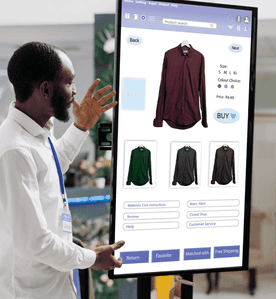MVP or Full Product: Manage Your Costs with Elastic Teams
Sector: Digital Product
Author: Nisarg Mehta
Date Published: 05/02/2023

Contents
Bringing a product to market can be costly, especially if you’re unsure whether it will be successful. That’s why many companies opt to develop a Minimum Viable Product (MVP) first, to test the waters and see if there’s a market for their idea.
But how can you build an MVP without overspending on your budget? And what if your MVP takes off, and you need to scale quickly? This is where the concept of elastic teams comes into play.
By building a team that can flexibly expand or contract based on your needs, you can manage your costs effectively while still delivering high-quality products. These teams are called augmented teams, and the model is called Team Augmentation.
When it comes to building a product, there are several engagement options available to companies, including outsourcing, managed services, and staff augmentation. Staff augmentation, in particular, has gained popularity in recent years due to the ease of collaboration among remote teams.
So what is staff/team augmentation, and how does it work?
Team Augmentation Model
Staff augmentation is a flexible hiring model that involves bringing in temporary workers to supplement your existing team and fill specific skill gaps. These temporary workers are usually contractors or freelancers who work remotely or on-site and are managed by your team.
Benefits of the Team Augmentation Model
One of the key advantages of team augmentation is that it helps you to quickly scale your team up or down based on your project’s needs. This is especially useful when building an MVP, as you may need to pivot or adjust your strategy based on user feedback.
With staff augmentation, you can easily bring on additional talent or reduce your team size as needed without committing to long-term contracts or hiring full-time employees.
Another benefit of staff augmentation is cost savings. Rather than hiring full-time employees, which can be expensive and time-consuming, you can hire contractors or freelancers on a project-by-project basis. This can help you manage your costs more effectively and reduce overhead expenses.
Drawbacks of the Team Augmentation Model
Of course, staff augmentation is not without its drawbacks. Compared to other engagement options, such as outsourcing or managed services, staff augmentation requires more oversight and management from your team.
You’ll need to ensure that your temporary staff members are integrated into your team and understand your project’s goals and timeline.
However, if managed properly, staff augmentation can be a highly effective way to build a high-quality product while managing your costs.
So how do you do it? How do you make sure that you can successfully build an MVP and scale up further using staff augmentation?
Let’s find out.
Building MVP with Team Augmentation
The team augmentation model is an effective way to build an MVP while managing costs and minimizing risks. Here is how you can get going:
1. Identify Your MVP Architecture and Identify Technology Gaps
You should start by defining the technical requirements for your MVP and identifying any technology gaps that need to be filled.
You’ll need to define your MVP architecture, including the programming languages, frameworks, and technology tools that will be used to develop it. This may involve conducting a technology stack analysis to determine which technologies will best meet your project’s needs.
During this step, you’ll also need to identify any skill gaps in your existing team that need to be filled by temporary staff members. This can be done by conducting a skills assessment to determine which roles and expertise levels are required for your project.
2. Identify Your Staffing Needs
With your MVP architecture and technical requirements in place, you’ll need to determine your staffing needs. This includes identifying which roles you need to fill, such as developers, designers, or project managers, and what level of expertise is required.
You can conduct an internal workforce analysis to determine the skills and experience required for each role. This can be done by reviewing job descriptions, conducting interviews, or reviewing resumes and portfolios.
3. Hire Team Members
Once you’ve identified your staffing needs, you’ll need to find the right candidates for your team. This may involve reaching out to staffing agencies, reviewing resumes and portfolios, and conducting interviews or assessments.
Make sure that the agency you reach out to has the best quality candidates that are available for the efforts you require.
Also, to effectively vet candidates, you’ll need to assess their technical skills, experience, and fit with your team and project goals. This can be done by conducting technical tests, reference checks, or personality assessments.
4. Onboard the Staff
Once you’ve identified your staff members, you’ll need to onboard them and integrate them into your existing team. This may involve introducing them to the development approach, setting up communication channels, and establishing project goals and timelines.
To effectively onboard your team members, you’ll need to provide clear instructions and expectations, establish protocols, and provide ongoing support and feedback.
5. Manage and Monitor Your Team
Throughout the MVP development process, you’ll need to manage and monitor your team’s progress. This includes providing feedback, resolving any issues or conflicts, and ensuring that your staff members are meeting project goals and timelines.
To effectively manage your team, you must establish clear project goals and timelines, set up regular check-ins and status updates, and provide ongoing feedback and support.
For this, You can use project management tools, such as Jira or Trello, to track progress and communicate with your team.
6. Evaluate and Adjust
Finally, once your MVP is complete, you’ll need to evaluate its success and adjust your strategy as needed. This may involve scaling up or down your team size, bringing on additional staff members for further development, or pivoting your strategy based on user feedback.
To effectively evaluate your MVP, you’ll need to measure its performance against your project goals and KPIs, conduct user testing and surveys, and gather feedback from stakeholders.
Scaling Up to Full Fledged Product with Staff Augmentation
Moving your product from MVP to full-scale development is a major milestone, but it can be challenging to know when the time is right. However, by taking a strategic approach and following some best practices, you can increase your chances of success.
Here are some best practices to consider:
- Develop a roadmap: Before you start augmenting your team, develop a clear roadmap that outlines your product’s growth trajectory. This will help you identify key milestones and staffing needs and ensure that your team is aligned with your product goals.
- Build a diverse team: To support product scale-up, it’s important to build a diverse team with a range of technical and domain expertise. This can help you tackle complex technical challenges and ensure that your product meets the needs of a broad range of users.
- Leverage agile methodologies: Agile methodologies can be particularly effective for product scale-up, as they enable you to quickly iterate and adapt your product to changing user needs. Establish a clear, agile framework for your team, and regularly assess your progress against your roadmap.
- Foster a culture of collaboration: To support effective team augmentation, it’s important to foster a culture of collaboration and knowledge sharing. Encourage your team members to work collaboratively, share best practices, and learn from each other’s expertise.
- Invest in training and development: To ensure that your augmented team is equipped with the skills and knowledge needed to support product scale-up, invest in training and development programs. This can help your team members stay up-to-date with the latest technologies and industry trends.
- Regularly assess team performance: Regularly assess team performance against key metrics to ensure that your augmented team is delivering value to your product. This helps you identify areas for improvement, adjust your strategy as needed, and ensure that your product is on track to meet its growth goals.
Best Practices to Work with Augmented Teams
Although we’ve mentioned some of the best approaches to build MVP and scale-up using augmented teams, here we’re taking a deep dive.
- Prioritize communication skills when hiring developers: In addition to technical expertise, it’s crucial to evaluate the communication skills of potential team members. The success of team augmentation largely depends on the communication between the local team and the consulting firm. Additionally, it’s essential to ensure that the developers culturally fit with the local team.
- Request a dedicated person for long-term projects: When working with a staff augmentation team, request that the management assign a dedicated person for your long-term projects. This way, your core team will only have to communicate with one point of contact, streamlining the communication process.
- Assess in-house competencies before augmenting the team: Before augmenting the team, ensure that your in-house team has the necessary competencies to effectively maintain a team of developers. For instance, if your team lacks technical talent, create an appropriate structure within your team. Typically, a staff augmentation team has a broad range of talent available to hire and includes an in-house manager and developer, but the structure depends on the stage of product development and the project.
- Notify the outsourcing team promptly: If your project is growing or you need vendor services for other projects, notify the outsourcing team as soon as possible. This will enable the recruiter from the vendor side to provide you with services promptly.
- Encourage knowledge transfer: When working with an external provider, it’s common to encounter new developers. To ensure smooth onboarding, create support documentation and collect more information and materials about the different phases of the project to facilitate knowledge transfer.
Conclusion
Staff augmentation is a viable solution for companies looking to build MVPs or scale up their products without incurring significant costs.
By following the right strategy, companies can leverage the benefits of staff augmentation and build a competent, dedicated team.
If you’re looking to hire pre-vetted developers for your MVP or scale-up project, feel free to reach us at Techtic. Our staff has experience working under agile frameworks. This allows you to get started with our resources right away. Let’s talk further.



